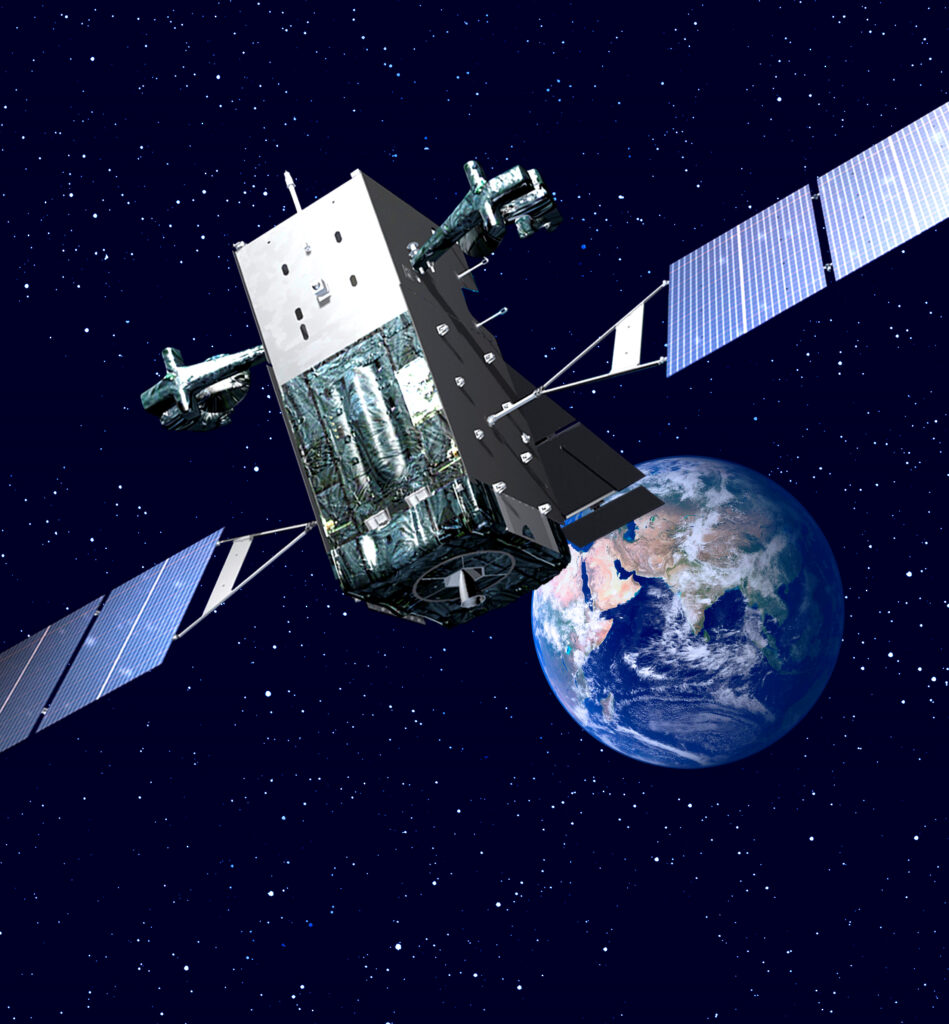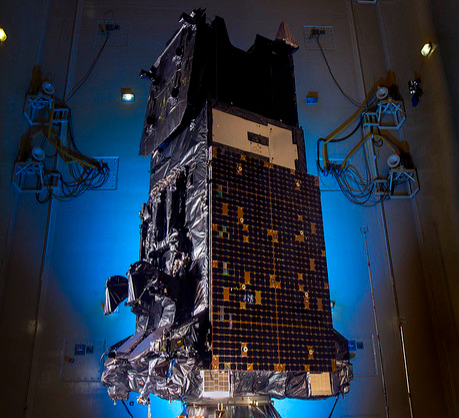
Space Based Infrared System (SBIRS) satellite
CLARIFICATION/UPDATE: To reflect that the SDA Tracking Layer satellites will be able to directly tip and queue other OPIR satellites in future; and the resumption of the program.
WASHINGTON: The $4.9 billion contract to produce three Next-Generation Overhead Persistent Infrared (Next-Gen OPIR) missile warning satellites seems to fly in the face of loudly touted Air and Space Force efforts to embrace open standards and cut the number of ground stations, receivers and antennas, experts said.
Instead, the new contract awarded to Lockheed Martin includes bespoke ground systems and sensor processing software — raising questions in particular about how the data collected eventually will be shared with the Space Development Agency’s ballistic and hypersonic missile tracking sats.
The production contract, announced yesterday, follows the firm’s 2018 award of $2.9 billion for development of Next-Gen OPIR, which will eventually replace the current Space Based Infrared System (SBIRS) satellites. The new award, managed by the Space Force Space and Missile System Center, covers “all work associated with the manufacturing, assembly, integration, test, and delivery of three Next Generation Geosynchronous (NGG) Earth orbiting space vehicles (SV), and delivery of ground mission unique software and ground sensor processing software” (emphasis ours.)
“Next Gen OPIR is a critically important program for our nation, providing advanced missile warning capabilities with a new level of resiliency that can keep us ahead of rapidly evolving threats,” said Tom McCormick, Lockheed Martin’s vice president for overhead persistent infrared systems, in an email statement. “A space program of this size — which includes developing two entirely new missile warning payloads — has never moved this fast. Working in close partnership with the Space and Missile Systems Center, we remain on track to launch the first space vehicle in 2025.”
Todd Harrison, director of the Aerospace Project at the Center for Strategic and International Studies (CSIS), said that “it’s not surprising that [Next-Gen OPIR] would require new software capabilities and ground stations” because the satellites will carry new sensors, but “there are a lot of open questions” about future compatibility and machine-to-machine data sharing capabilities.
What is crystal clear is that in the near-term, there will be no direct, machine-to-machine data transfer between the new Next-Gen OPIR satellites expected to first fly in 2025, and the first Space Development Agency (SDA) planned Missile Tracking Layer satellites constellations, expected to launch in 2022.
“You would think it would be advantageous for one [OPIR] space system to be able to queue the other space system … to be able to pass data directly between the two,” Harrison said somewhat sardonically. “That’s ideally what you would want.”
“While SDA satellites are not currently expected to “talk to” the Next Gen OPIR satellites via space-to-space communication, nor share ground stations, the systems will work in concert with one another to address the broad range of OPIR needs,” SDA spokesperson Jennifer Elzea told me in an email.
CLARIFICATION STARTS. However, “in the future, SDA expects other OPIR sensors in the GEOINT Enterprise will be used to tip and queue SDA’s OPIR sensors and vice versa,” she explained. CLARIFICATION ENDS.
Both Next-Gen OPIR and the Tracking Layer are designed to provide targeting data to missile defense systems overseen by the Missile Defense Agency (MDA) and operated by the services. These include the Army-operated, Air Force supported Ground-based Midcourse Defense System (GMD) and the Navy operated Aegis Ballistic Missile Defense system based on the Standard Missile-3.
The lack of a direct link between two new — not legacy — satellite systems also seems out of step with the Air and Space Force effort to craft a plan to determine what missile warning systems are needed for today and tomorrow, how legacy and new systems are integrated, and who is responsible for what. This “missile warning architecture” was mandated by Congress in the 2020 defense spending bill.
Elzea explained that instead the plan is for OPIR data to be collated via current ground systems. “The baseline vision for the interface between legacy OPIR systems like SBIRS and Next Gen OPIR and the SDA Tracking Layer will be within message protocols used by existing ground systems. Data derived from SDA’s Tracking Layer will be provided to the OPIR GEOINT enterprise to augment other data collected by other OPIR sensors.”
Space Command “requested U.S. Space Force, Missile Defense Agency (MDA), and Space Development Agency (SDA) standardize their respective Overhead Persistent Infrared (OPIR) messages,” although each user will have the freedom to determine what information they need for their own operations, SMC spokesperson Capt. Kaitlin Toner elaborated in an email.
Further, she explained, data integration from all the OPIR satellite systems will soon be integrated under the Space Force’s Future Operationally Resilient Ground Evolution (FORGE) program.
“FORGE will translate the OPIR data into formats currently supported by the OPIR community and will disseminate that data using the enterprise solution that is being developed under the Joint OPIR Ground (JOG) initiative. U.S. Space Force, MDA, and other users will then subscribe to this data just like they do for other data sources today. FORGE will maximize the utilization of existing formats, but may need to propose new formats and standards as needed. Those new standards, if accepted, will then be integrated into the enterprise dissemination solution. Similarly, SDA’s space tracking layer will publish their data in the same standardized formats,” Toner said.
“The result is that data from both Next-Generation OPIR and SDA’s space tracking layer, in addition to Space Based Infrared System (SBIRS), Defense Support Program (DSP), and other existing sensors, will be available to all members of the enterprise in a nearly ‘plug and play’ fashion. Those partners will need to modify their systems to use the new data, however the interfaces should remain the same.”

Next-Gen OPIR missile warning satellite under construction, Lockheed Martin photo
But if you read between the lines of the Next-Gen OPIR production contract announcement, it becomes clear that Lockheed Martin will be building a new stand-alone Next-Gen OPIR ground system, at least in the near term. This is because FORGE will not be available until after 2025 when the first Next-Gen OPIR satellite is to launch.
Raytheon on Jan. 28, 2020 won a $197 million contract to develop FORGE, using the company’s open-source, software-centric Mission Data Processing Application Framework (MDPAF) to process data from Next-Gen OPIR and SBIRS. The development contract has a five-year term — meaning that even if the schedule doesn’t slip, production versions of the system will not be available before the first Next-Gen OPIR satellite flies.
Harrison and industry experts noted that, in all fairness, the Next-Gen OPIR and SDA Tracking Layer satellites have slightly different missions — a fact that does mean that they will require slightly different software code for processing the infrared images they collect.
The Next-Gen OPIR constellation — which includes the three Lockheed Martin birds in Geosynchronous Orbit (GEO, some 36,000 kilometers in altitude) as well as two in polar crossing orbits being built by Northrop Grumman — are designed to detect missile launches.
SMC back in May announced that the two candidate infrared sensor payloads for Next-Gen OPIR — one being developed by Northrop Grumman Aerospace Systems and Ball Aerospace; the other by Raytheon Space and Airborne Systems — had passed their preliminary design reviews. According to the SMC release, SMC and Lockheed Martin will choose the payload the first two NGG satellites; Lockheed Martin will then select a provider for the third satellite. However, industry sources said, it remains to be decided whether the same payload will be used for all three, or whether there will be a mix and match of both vendors sensors — or perhaps even a decision to put both payloads on a single satellite.
The SDA Tracking Layer satellites by contrast will focus on tracking both ballistic and hypersonic cruise missiles after launch.
SDA in October awarded SpaceX $149 million and L3Harris $194 million to each build four Low Earth Orbit (LEO, below 2000 kilometers in altitude) satellites for the agency’s Tracking Layer Tranche 0, designed to detect ballistic, cruise and hypersonic missiles using a wide field of view IR sensor. The low-cost satellites are supposed to “provide missile warning and tracking information to national defense authorities, and tracking and cueing data for missile defense elements,” according to SDA officials.
SDA’s plans to launch in 2022 are for the moment extant, despite having re-opened the award for review of bids following a series of bid protests by Raytheon, as succinctly wrapped up by colleague Sandra Erwin late last month.
UPDATE STARTS. Elzea said in a follow-up email that work recommenced Dec. 28 on the Tranche 0 Tracking Layer contracts following a a temporary stop-work order. “SDA implemented a corrective action plan for the Tracking Tranche 0 competition after initial awards received protests. The reevaluation confirmed the original selection decision announced in October.”
“SDA is confident that reevaluation resulted in a fair outcome for all involved parties. The Agency continues to make all efforts to keep the Tracking Layer of the National Defense Space Architecture on schedule,” she added.
SDA’s goal is to have eight Tracking Layer satellites, along with the 20 planned Transport Layer satellites making up Tranche 0 by no later than March 31, 2023. The five Next-Gen OPIR satellites, however, aren’t expected to be on orbit until 2029. (This means, one expert pointed out that if the Space Force’s intention is to ensure that the two systems can directly interface in their initial configurations — rather than waiting for a new Block 1 configuration for Next-Gen OPIR — the onus is on SMC to figure out how to directly interface with the SDA birds.) UPDATE ENDS.
On the other hand, the creating a common terminal is the entire goal of FORGE, and the longer term Enterprise Ground System (EGS) initiative to create a common ground service that provides similar command and control functions to multiple satellite constellations by 2028.
“It flies in the face of their entire EGS enterprise ground system,” a former senior DoD space official told me. “There’s this fiction being broadcast about EGS and all this other kind of stuff, and then there’s the reality of what’s really happening … and they couldn’t be further from each other.”
One problem is that SMC and SDA aren’t actually integrating their acquisition efforts, the source added. “The fiction that SDA and SMC are working together is just that. You know, they make nicey-nicey, but, the reality is that they’re not working together.”
Norway’s top officer on his ‘biggest challenge,’ next frigate and new NATO neighbors
Gen. Eirik Kristoffersen, Norway’s Chief of Defense, talks to Breaking Defense about his plans for spending on new frigates and subs, the challenges of upgrading Norway’s “digital backbone” and refilling the military’s stocks.


























